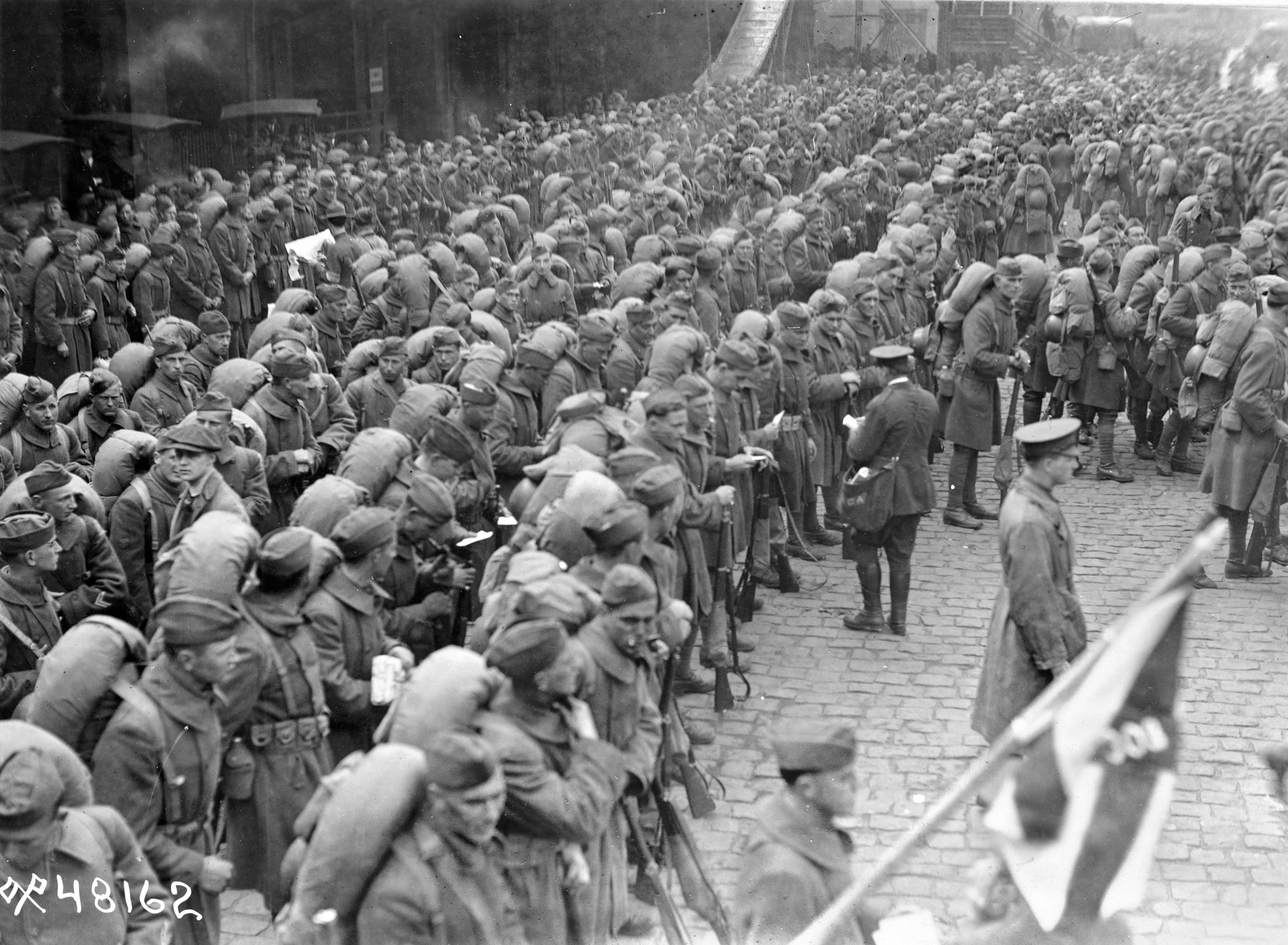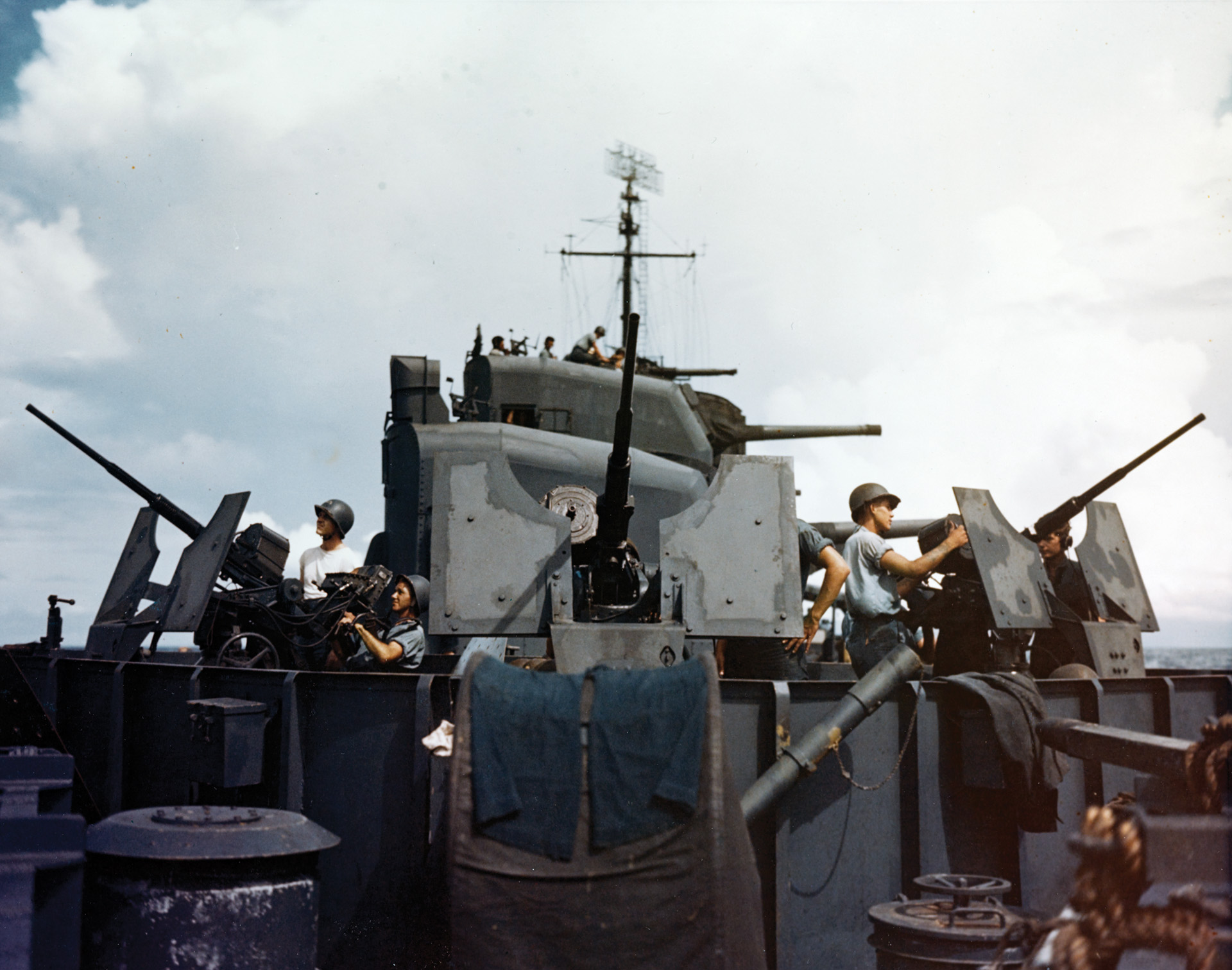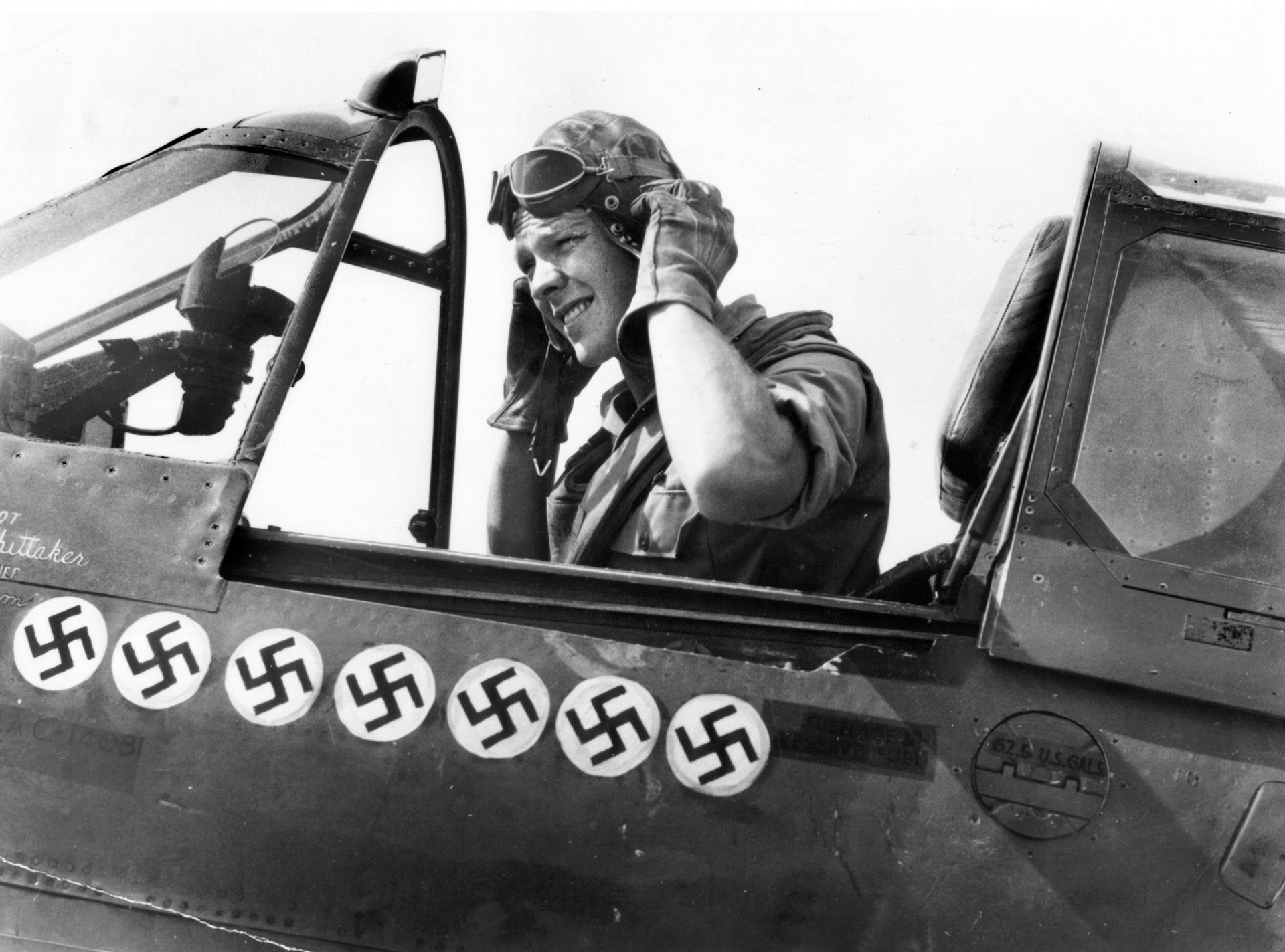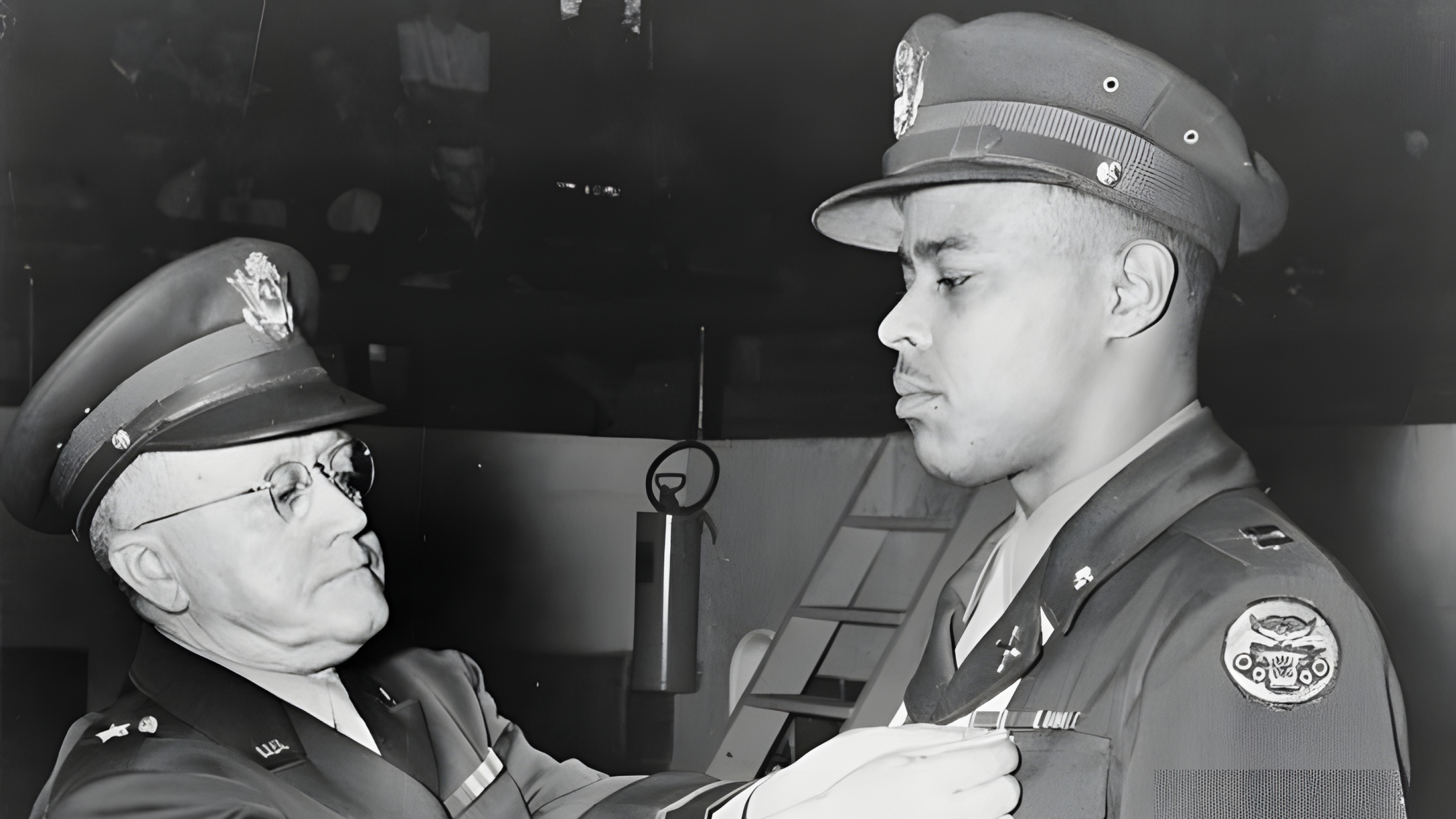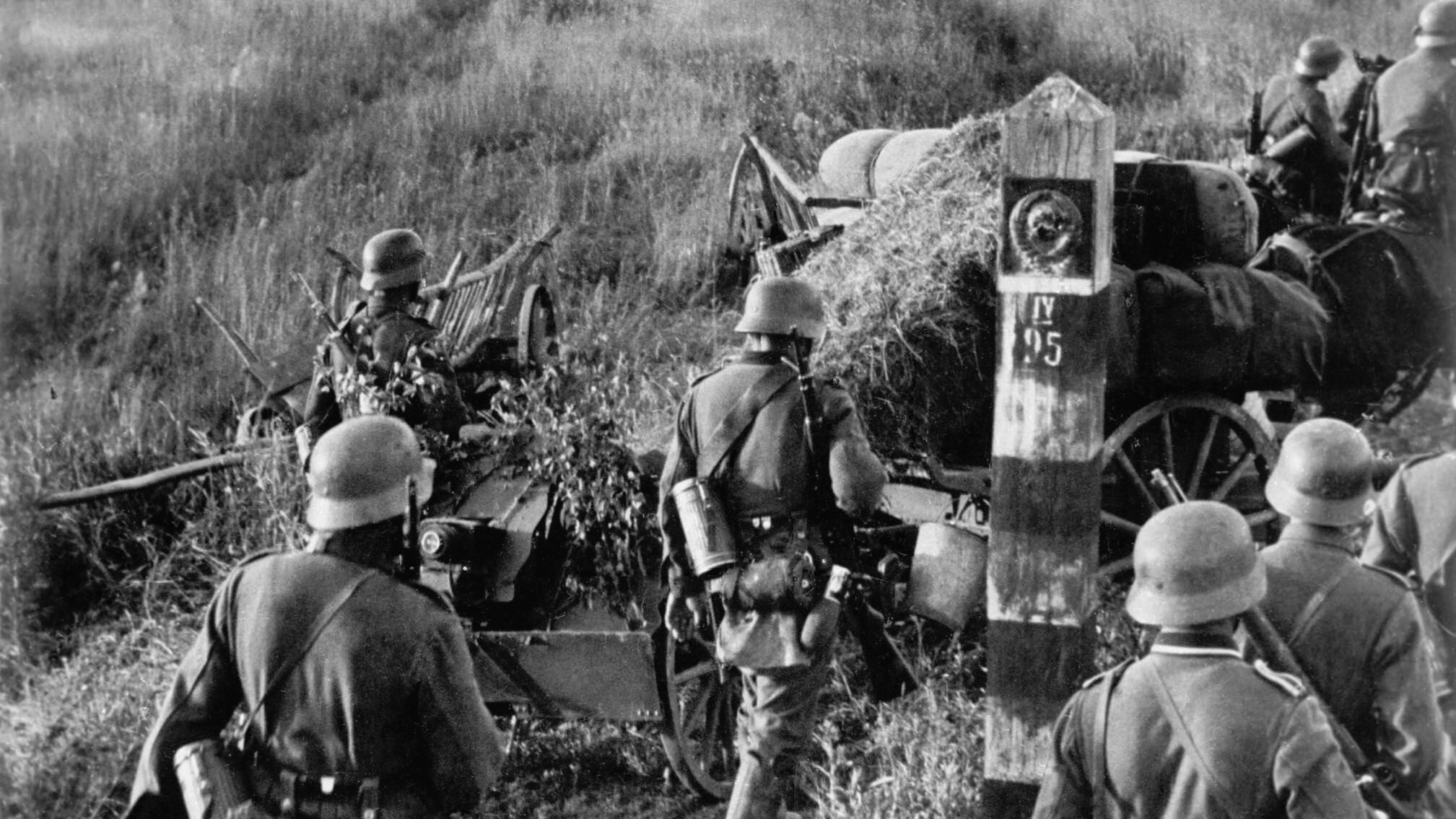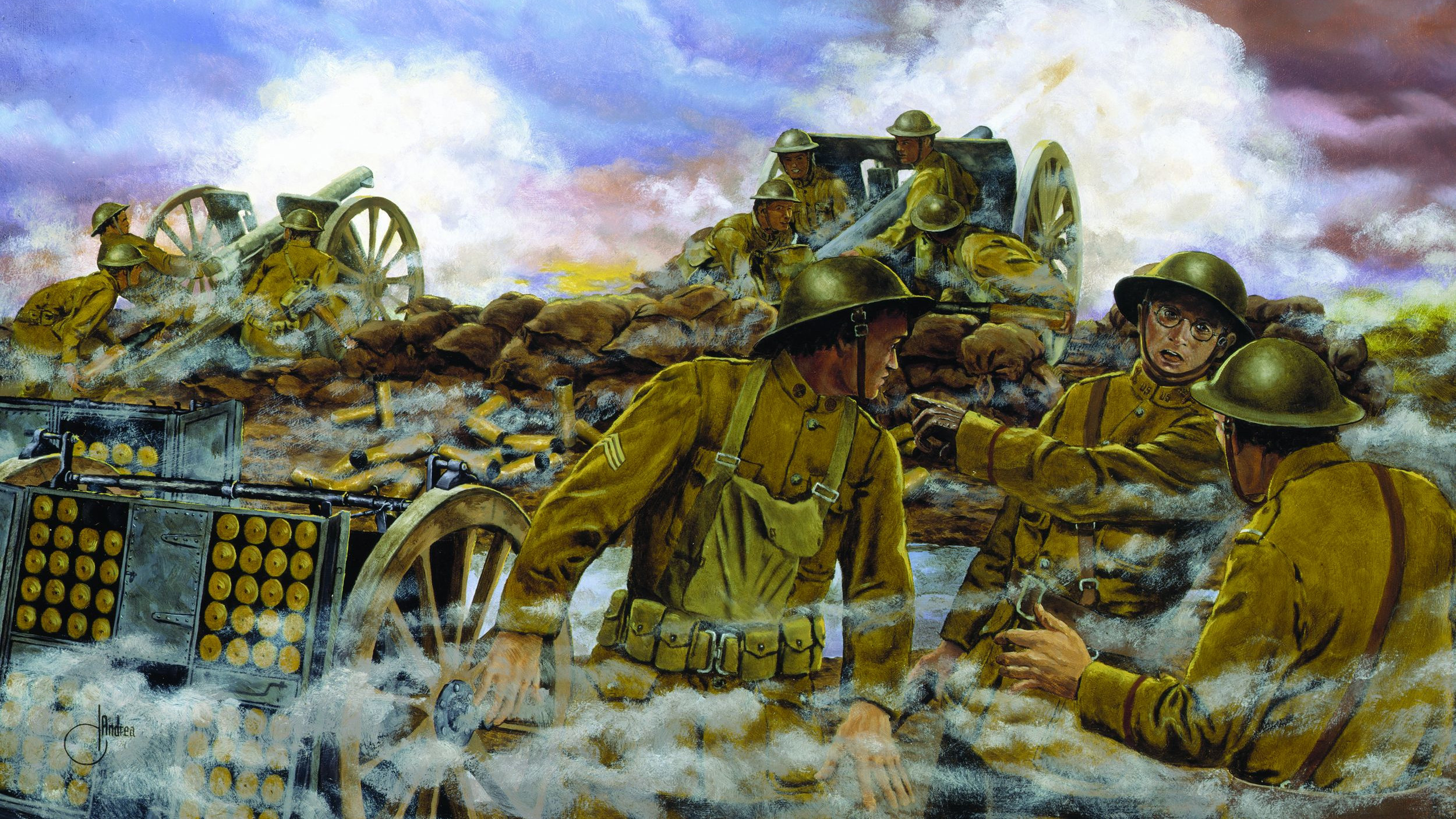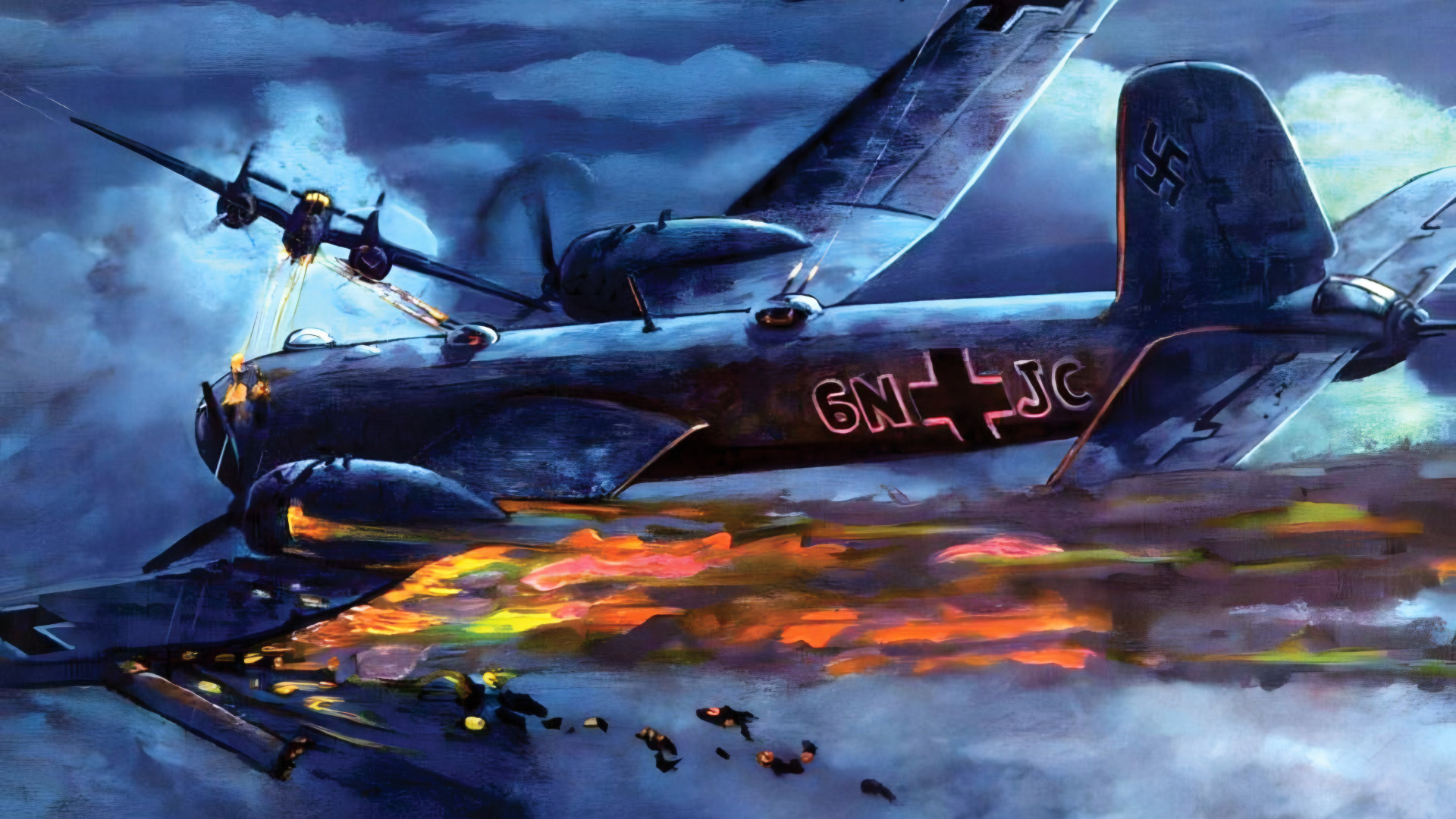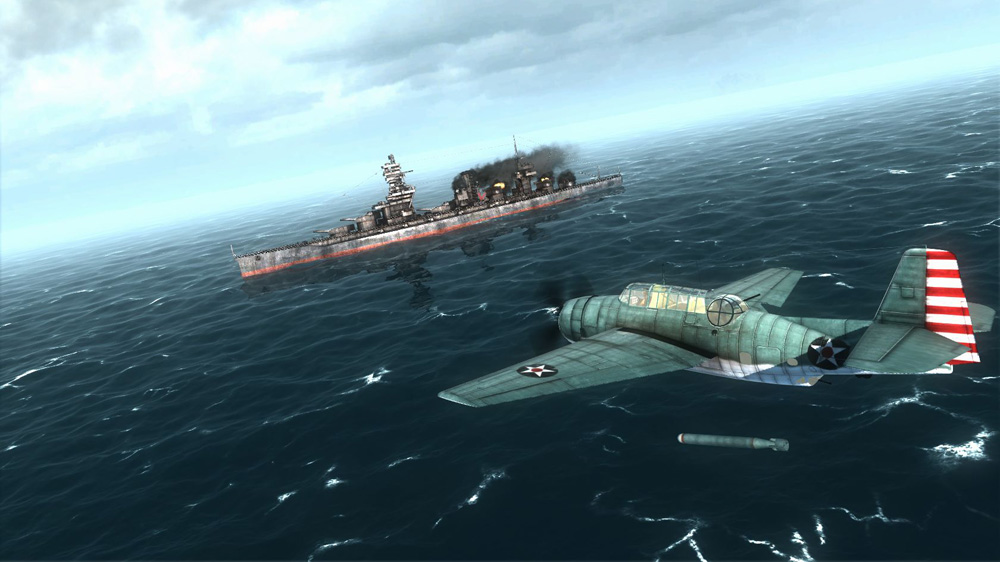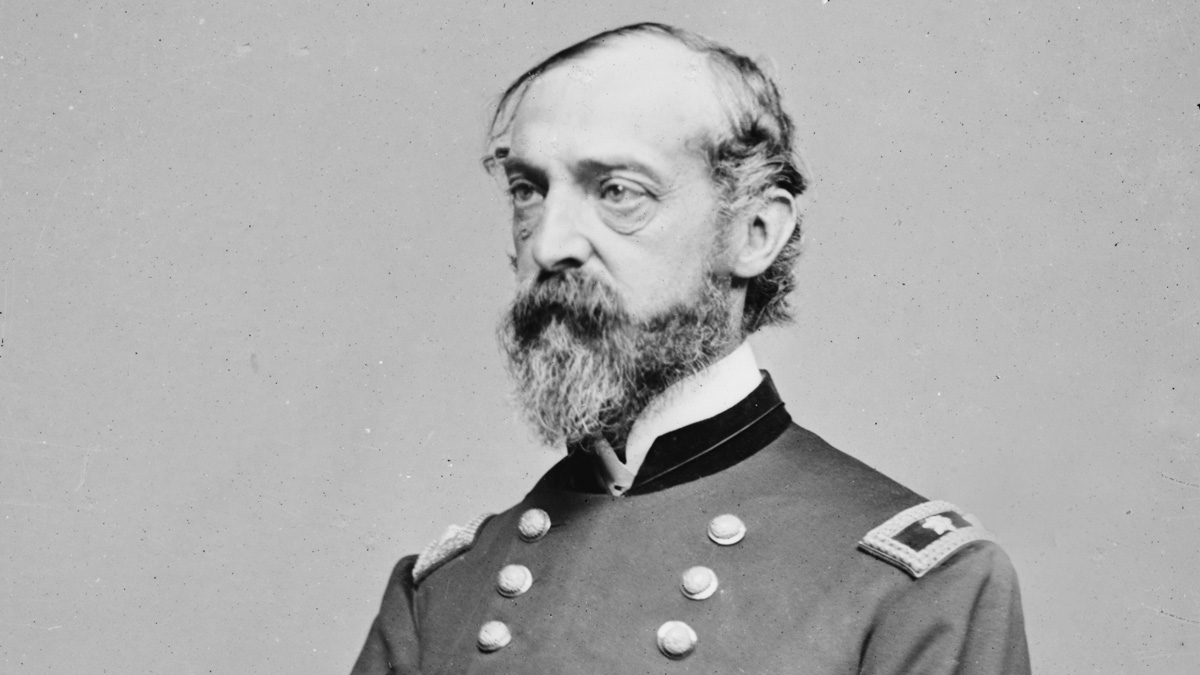By Christopher Miskimon
Lines of drab-uniformed soldiers emerged from their night march and moved down a forested road into open country on September 26, 1918. Shell craters dotted the landscape amid splintered trees. The ground shook slightly from the impact of distant artillery. Flashes from the explosions dotted the skyline. As the men moved into muddy trenches, sergeants whispered directions. The American
308th Infantry Regiment, 77th “Metropolitan” Division was about to attack the German lines. The friendly artillery that paved the way for their assault kept falling for over three hours, intensifying as dawn approached. At 5:55 am the men rose from the trenches and advanced, walking slowly behind the moving barrage, which preceded them into the dark treeline ahead.
The force’s commanding officer, Major Charles Whittlesey, went with them. He pushed Lieutenant Edward N. Lewis out of the trench. “Let’s go,” Whittlesey said to the lieutenant. Lewis climbed out, turned, and helped Whittlesey out. Both men then went forward into a landscape that resembled the surface of the moon.
Whittlesey was ill, suffering from both dysentery and a sore throat, but he continued forward with his men. Smoke obscured the battlefield in the dim, early-morning light. He heard men yelling on either side of him, along with the occasional rifle shot. They soon encountered ruined barbed wire and blasted trenches. Whittlesey reached for his pistol but there was nothing to shoot. Several men were disgusted upon discovering bodies that turned out to be the moldy skeletons of long-dead French soldiers. As they advanced, the Americans scrambled over fallen trees and through craters. Whittlesey issued occasional orders but no one could hear him over the shouting.
 At 7 am the American major sent word his battalion was “progressing favorably with little opposition” but he had no idea how far they had come; the fog obscured the distance too well. He set up a command post in an old German dugout and tried to figure out what was going on ahead of him. As he did so, a private walked past with a prisoner, covering the German with a flare pistol. Whittlesey studied his map and realized his unit had gone about a mile and a quarter. He noted that their objective was only a few hundred yards away. The planners back at headquarters carelessly placed it in the middle of a swamp. He ordered the advance to stop there.
At 7 am the American major sent word his battalion was “progressing favorably with little opposition” but he had no idea how far they had come; the fog obscured the distance too well. He set up a command post in an old German dugout and tried to figure out what was going on ahead of him. As he did so, a private walked past with a prisoner, covering the German with a flare pistol. Whittlesey studied his map and realized his unit had gone about a mile and a quarter. He noted that their objective was only a few hundred yards away. The planners back at headquarters carelessly placed it in the middle of a swamp. He ordered the advance to stop there.
Whittlesey’s initial foray into combat turned out to be simple compared to what lay ahead. Soon seven companies of the 308th, accompanied by two companies of the 306th Machine Gun Battalion, would be cut off behind German lines when their flanking units failed to advance with them. Their ordeal is revealed in Never in Finer Company: The Men of the Great War’s Lost Battalion (Edward G. Lengel, Da Capo Press, Boston, MA, 2018, 368 pp., maps, photographs, notes bibliography, index, $28.00, hardcover).
This fresh look at the story of the Lost Battalion is told primarily through the experiences of four men. Charles Whittlesey commanded the unit and led them through the desperate situation. Company commander Captain George McMurtry was a New York stockbroker who inspired his troops during the difficult battle. Sergeant Alvin York gained fame for his actions while helping in the rescue attempt, but he struggled with guilt after seeing men near him killed. Reporter Damon Runyon, famed for his sports coverage, interviewed as many participants as he could and wrote accounts of the disastrous action. It is a story of courage under extreme adversity, with soldiers placed into a situation where either surrender or flight seemed preferable; instead, they endured despite horrible losses and deprivation.
The author gathered the accounts of these four men, along with others, and wove them into a tapestry of prose that is clear, direct, and dramatic. The author reminds the reader of the heavy sacrifice made by the men, and how they suffered under the hardship imposed upon them. The focus is kept squarely where it belongs, on the Lost Battalion’s leaders and soldiers. The descriptions are vivid, providing a clear picture of the battlefield and the events.
The author also extends his work to after the war, revealing how the survivors dealt with their experiences and the stress, in a time when post-combat stress issues were not recognized or dealt with. Many books have been published about World War I during the conflict’s recent centennial. This one stands out as a battle story of normal men thrown into the abnormal maelstrom of combat.
 Leathernecks: An Illustrated History of the United States Marine Corps (Merrill L. Bartlett and Jack Sweetman, Naval Institute Press, Annapolis, MD, 2018, 479 pp., maps, photographs, bibliography, index, $55.00, softcover)
Leathernecks: An Illustrated History of the United States Marine Corps (Merrill L. Bartlett and Jack Sweetman, Naval Institute Press, Annapolis, MD, 2018, 479 pp., maps, photographs, bibliography, index, $55.00, softcover)
For most of its first hundred years of existence the Marine Corps was seldom larger than a single regiment. During its second century it grew to a size rivalling many armies and established a fierce reputation for courage and sacrifice. The mere mention of the word Marine is enough to frighten combatants around the world. How that came to be is the subject of this new paperback edition of the Marine Corps’ long history.
The work is extensively illustrated and full of the personal stories that make the Marine Corps story so fascinating. It serves as a coffee table book which nevertheless is accurate, detailed, and concise. The work stands out as a good general history of the famed American service arm.
 The Polar Bear Expedition: The Heroes of America’s Forgotten Invasion of Russia (James Carl Nelson, William Morrow Publishing, New York, 2019, 320 pp., photographs, notes, bibliography, index, $28.99, hardcover)
The Polar Bear Expedition: The Heroes of America’s Forgotten Invasion of Russia (James Carl Nelson, William Morrow Publishing, New York, 2019, 320 pp., photographs, notes, bibliography, index, $28.99, hardcover)
In August 1918, 5,000 American soldiers of the 339th Infantry Regiment set sail for Archangel, Russia, 1,000 miles northeast of Moscow. That nation reeled in the turmoil of a civil war. The American North Russia Expeditionary Force, known to its men as the “Polar Bear Expedition,” travelled with the aim of reopening the Eastern Front against Germany by fighting the communist forces that embroiled that land.
It was a punishing campaign fought largely in autumn and winter. Cannons and machine guns froze into inoperability and sentries were frostbitten. When they were withdrawn the following July, more than 200 men were lost from combat, illness, and injury. Ten years later, a contingent of the regiment’s veterans returned to Russia, recovered the remains of 100 of the fallen, and took them home.
The experiences of the doughboys of the Russian Expedition are skillfully relayed in this new book. It is well researched using primary sources. The writing is clear and the narrative engaging. It is full of the small stories that lend the work authenticity.
 The Deadly Deep: The Definitive History of Submarine Warfare (Ian Ballantyne, Pegasus Books, New York, 2018, 752 pp., maps, photographs, appendices, glossary, notes, bibliography, index, $35.00, hardcover)
The Deadly Deep: The Definitive History of Submarine Warfare (Ian Ballantyne, Pegasus Books, New York, 2018, 752 pp., maps, photographs, appendices, glossary, notes, bibliography, index, $35.00, hardcover)
The submarine has evolved over a near century and a half of use. It began as a relatively ineffective and derided warship, but now is among the most powerful and feared in the oceans. They developed a reputation as commerce raiders ever since the German U-boat U-17 sank the British merchantman Glitra off the coast of Norway in October 1914. On that occasion the captain gave the crew a chance to abandon ship and towed their lifeboats nearer the coast to increase their chances of rescue. Not all merchant crews in the 20th century would be so lucky.
World War I marked the birth of the submarine as an effective weapon of war and this importance culminated during World War II, when U-boats prowled the Atlantic and almost brought England to her knees, while American submarines did the same to Imperial Japan. After the war submarines became ultimate weapons when they carried ballistic missiles.
The author uses the major episodes of submarine warfare to illustrate its history. The book is an interesting combination of technical details and the human stories of those who crewed these undersea warships. Its strength is in these myriad small tales of submarines in action that combine to make up the extensive narrative. This makes the book enjoyable to read throughout and a worthy choice for a single volume on the topic.
 Holding the Line: The Naval Air Campaign in Korea (Thomas McKelvey Cleaver, Osprey Publishing, Oxford, UK, 2019, 320 pp., maps, photographs, bibliography, index, $30.00, hardcover)
Holding the Line: The Naval Air Campaign in Korea (Thomas McKelvey Cleaver, Osprey Publishing, Oxford, UK, 2019, 320 pp., maps, photographs, bibliography, index, $30.00, hardcover)
Less than two weeks after North Korea invaded the south, U.S. Navy carrier aircraft struck the airfield at Pyongyang, the North Korean capital. An Anglo-American carrier task force approached the coastline undetected and launched 16 Corsairs, 12 Skyraiders, and eight Panther jet fighters, while the British sent 21 planes to another airfield. When the Panthers arrived over Pyongyang, they spotted a pair of Yak-9s in the air. Both were shot down and nine more enemy planes were strafed on the field. Another strike that afternoon hit the rail yards. The damage done that day was significant if not overwhelming, but it had a decisive effect.
The quick response of American airpower caused Soviet leader Joseph Stalin to reverse a fateful decision. He chose not to deploy Soviet aircraft to North Korea and ultimately decided not to directly intervene in the war with Soviet troops, although “volunteer” pilots would serve. This was an important limit on the war that helped keep it from expanding out of control.
The Navy’s air operations during the Korean War are not as well known as those of the USAF but they were no less important. This history covers the major facets of the Navy’s part in the conflict. The book covers the transition from propeller-driven planes to jet aircraft, though the two types served together. It also discusses how the U.S. Navy’s performance saved it from prewar budget cuts. The author also provides details on the daily life of the sailors and aviators who served during the war.
 River of Death: The Chickamauga Campaign Volume One, The Fall of Chattanooga (William Glenn Robertson, University of North Carolina Press, Chapel Hill, 2018, 696 pp., maps, photographs, appendix, notes, bibliography, index, $45.00, hardcover)
River of Death: The Chickamauga Campaign Volume One, The Fall of Chattanooga (William Glenn Robertson, University of North Carolina Press, Chapel Hill, 2018, 696 pp., maps, photographs, appendix, notes, bibliography, index, $45.00, hardcover)
The Battle of Chickamauga was the third bloodiest engagement of the American Civil War. William S. Rosecrans’s Army of the Cumberland met Braxton Bragg’s Army of Tennessee after months of maneuver and preparation. The result was more than 34,500 casualties and the Confederacy’s only major victory in the western theater of the war.
This work is the first of a two-volume set examining the operations of both armies from July 1863 until September 9, when Bragg made the decision to abandon Chattanooga. These events led to the fateful battle on September 19-20, 1863.
The author examines the use of railroads and intelligence gathering by both sides, with special attention paid to the opposing leaders and their staffs. Chickamauga was more than just a single engagement. A long and complex chain of events culminated in the battle. This new work describes that path for the reader.
 Tsushima 1905: Death of a Russian Fleet (Mark Lardas, Osprey Publishing, Oxford, UK, 2018, 96 pp., maps, photographs, bibliography, index, $24.00, softcover)
Tsushima 1905: Death of a Russian Fleet (Mark Lardas, Osprey Publishing, Oxford, UK, 2018, 96 pp., maps, photographs, bibliography, index, $24.00, softcover)
This naval engagement changed history. It became the culmination of the Russo-Japanese War. The defeat of Russia by a rising Asian power was a shock to the Western world and a hint of things to come.
Tsushima was a close-fought contest. Russian gunnery excelled at the battle’s opening. The Japanese battleship Mikasa shuddered though 15 hits in the first five minutes. The armored cruiser Nisshin also suffered. Aboard the cruiser was a junior officer named Isoroku Yamamoto who lost two fingers to a Russian shell. If he had lost three fingers, he would have been medically discharged from the service; instead, he went on to become the marshal admiral of the Imperial Japanese Navy in World War II. Shortly afterward, the battle swung against the Russians. They were not only defeated, but compelled to surrender. The war made Japan a rising star and placed Russia another step down the road to revolution and communism.
This book effectively argues Tsushima was the most decisive battle of the 20th century. No other action was as one sided for the victors. The author makes his case through detailed research, showing how the battle played out and how it fit into the wider course of the war. The book is well illustrated with excellent maps and diagrams. The original artwork brings the battle to vivid life.
 African Samurai: The True Story of Yasuke, a Legendary Black Warrior in Feudal Japan (Thomas Lockley and Geoffrey Girard, Hanover Square Press, Ontario, Canada, 2019, 464 pp., photographs, notes, bibliography, $26.99, hardcover)
African Samurai: The True Story of Yasuke, a Legendary Black Warrior in Feudal Japan (Thomas Lockley and Geoffrey Girard, Hanover Square Press, Ontario, Canada, 2019, 464 pp., photographs, notes, bibliography, $26.99, hardcover)
Yasuke was unique among the Japanese Samurai as he was born in Africa. He was kidnapped as a boy and trained in India to be a soldier. From there, he became a bodyguard and indentured servant to a Jesuit leader and accompanied him through India and China and to the newfound Catholic missions in Japan.
After arriving in Nagasaki in the late 1500s, many Japanese, having never seen an African before, thought him an embodiment of Buddha or a war god. Yasuke eventually drew the attention of Lord Nobunaga, who led the most powerful clan in Japan. He made the African a samurai in his court. Yasuke learned their martial traditions, fought battles with them, and over time rose higher in Japanese society.
This story is almost mythical in Japan and practically unheard of elsewhere. The author did extensive research, uncovering new primary material and creating the first full book on Yasuke. It sheds light on 16th-century Japanese culture and history. It was a time not only of the shogun, ninja, and samurai, but also of an African man who travelled the world and became a respected warrior, breaking the stereotypes of what Africans could do in this period.
 Lucius Verus and the Roman Defence of the East (M.C. Bishop, Pen and Sword Books, South Yorkshire, UK, 2018, 176 pp., photographs, appendices, notes, bibliography, index, $32.95, hardcover)
Lucius Verus and the Roman Defence of the East (M.C. Bishop, Pen and Sword Books, South Yorkshire, UK, 2018, 176 pp., photographs, appendices, notes, bibliography, index, $32.95, hardcover)
Lucius Verus is one of the least well-regarded Roman emperors. He co-ruled with Marcus Aurelius, his adopted brother, for nine years until dying in ad 169. His life was tumultuous. During his childhood he lost two fathers, acquired a brother, and changed his name twice. He ascended to the rank of general almost overnight and went on to command the Roman army that defeated one of Rome’s greatest enemies during the Roman-Parthian War of 161-166. During this war the Romans campaigned in Mesopotamia and even seized Ctesiphon, the Parthian capital. This victory was so profound it earned him a triumph back in Rome. Despite this, he is not given the acclaim he might receive from modern writers.
The author makes an effective case to redress this ignorance of Lucius Verus in his new book. He uses contemporary writings about the man to show how he was thought of at the time. Using various source material, he also reassesses Verus’s handling of the war with Parthia after their invasions of Armenia and Syria. The book is a biography with an emphasis on the subject’s military leadership and acumen and includes information on his subordinate leaders and the troops who populated his victorious army.
 Short Bursts
Short Bursts
War of the Wolf (Bernard Cornwell, Harper Publishing, 2018, 28.99, hardcover) This novel continues the fictional adventures of Uhtred of Bebbanburg in the creation of England during the Dark Ages. The author is renowned for his storytelling and attention to historical accuracy.
Looming Civil War: How Nineteenth-Century Americans Imagined the Future (Jason Phillips, Oxford University Press, 2018, $34.95, hardcover) Decades before the first shot was fired at Fort Sumter, Americans were forecasting a coming civil war. This work reveals those predictions and their effect on the course of events.
Haig’s Enemy: Crown Prince Rupprecht and Germany’s War on the Western Front (Jonathan Boff, Oxford University Press, 2018, $34.95, hardcover) Rupprecht was the British Army’s most consistent opponent during the Great War. This work explores his experiences during the war.
Day of the Rangers: The Battle of Mogadishu 25 Years On (Leigh Neville, Osprey Publishing, 2018, $30.00, hardcover) This is a revisit to the famous “Blackhawk Down” incident. The author interviews veterans of the fighting to reconstruct the events.
 Not Enough Room to Swing a Cat: Naval Slang and Its Everyday Usage (Martin Robson, Osprey Publishing, 2018, $16.95, hardcover) The quirks and slang of naval language form a rich heritage that works its way into common usage. This volume compiles the phrases of the U.S., British, and Commonwealth navies.
Not Enough Room to Swing a Cat: Naval Slang and Its Everyday Usage (Martin Robson, Osprey Publishing, 2018, $16.95, hardcover) The quirks and slang of naval language form a rich heritage that works its way into common usage. This volume compiles the phrases of the U.S., British, and Commonwealth navies.
Road to Disaster: A New History of America’s Descent into Vietnam (Brian VanDeMark, Custom House, 2018, $32.99, hardcover) This new work explores the critical mistakes made by American leaders that led to the debacle in Vietnam.
The War that Forged a Nation: Why the Civil War Still Matters (James McPherson, Oxford University Press, 2017, $14.95, softcover) This is an exploration of why the Civil War is still so important in the American consciousness. It is a new paperback edition of a classic work.
The Invisible Emperor: Napoleon on Elba from Exile to Escape (Mark Braude, Penguin Press, 2018, $28.00, hardcover) Napoleon’s experiences on Elba influenced his later actions after his escape. This volume covers that time.
